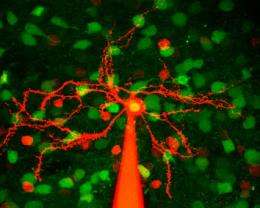Positive feedback in the developing brain

(Medical Xpress) -- When an animal is born, its early experiences help map out the still-forming connections in its brain. As neurons in sensory areas of the brain fire in response to sights, smells, and sounds, synapses begin to form, laying the neuronal groundwork for activity later in life. Not all parts of the brain receive input directly from the external world, however, and researchers have wondered how these regions build their wiring early in development.
New research from Howard Hughes Medical Institute investigator Bernardo Sabatini and colleagues on the basal ganglia, a region of the brain that controls motor planning, indicates that development here follows a different strategy. The new findings suggest that wiring of the basal ganglia during early development is driven not only by experience, but also by a self-reinforcing loop of neuronal signaling. As the loop strengthens, more synapses form.
“What we found is that silencing these neurons doesn’t really change their output patterns — of course they are silenced, but they still find their targets and survive — but instead drastically influences their inputs,” said Bernardo L. Sabatini.
The basal ganglia help an animal select its actions based on sensory and social context, as well as past experience. The new clues about how the basal ganglia gets wired shortly after birth, described in the May 13, 2012, issue of the journal Nature, may help scientists understand what happens when the area goes awry, such as in Parkinson's disease, when degradation of neurons in the basal ganglia interferes with patients’ ability to initiate appropriate movements, or drug addiction, where overstimulation of the basal ganglia spurs inappropriate actions. Sabatini says his team’s findings also suggest that the process can be easily perturbed during development, and may contribute to human disorders such as cerebral palsy and attention deficit hyperactivity disorder.
Although the basal ganglia do not receive direct messages from the external world, this region of the brain is by no means anatomically isolated: it receives signals from all over the cortex, and its output eventually returns to the cortex. Sabatini, who is at Harvard Medical School, explains that to select a motor action, the brain likely signals through that whole loop. “The question is, how do you lay down the circuits for those patterns?”
The basal ganglia are complex, containing many clusters of cells, some of which send excitatory signals and others inhibitory. Sabatini’s group focused on the basal ganglia’s main input station, the striatum. The striatum uses the information it receives to help direct movement in two ways: a ‘direct’ pathway stimulates motor actions and an ‘indirect’ pathway inhibits them. To learn how striatal activity affects circuit development, Sabatini’s team studied mutant mice whose indirect or direct pathways were turned off (because they were unable to release the inhibitory chemical messenger, GABA).
The group expected that silencing these neurons would prevent them from forming connections with the neurons that should have been receiving their signals. To their surprise, the silenced neurons survived and wired themselves to their targets normally. Unexpectedly, however, silencing the striatum’s direct pathway seemed to prevent formation of the connections sending input to the striatum. Silencing the indirect pathway upped the number of inputs. “We went into this study thinking completely differently,” says Sabatini. “What we found is that silencing these neurons doesn’t really change their output patterns — of course they are silenced, but they still find their targets and survive — but instead drastically influences their inputs.”
To see whether individual cells help set up the basal ganglia circuit, Sabatini’s group turned off a select few striatal neurons, rather than whole pathways, in the mice. They found that silencing these neurons did not affect excitatory connections to the area, suggesting that circuit-level activity patterns set up the basal ganglia’s wiring, rather than individual genes or molecules within cells. “It’s hard to believe that there are molecular cues that specify these structures, because it would be way too complicated,” Sabatini says.
When the group dampened activity in neurons that project from the brain’s cortex to the striatum during development, then examined the brain when the mouse had reached early adulthood (25 days after birth) they saw fewer neuronal connections in the striatum compared to mice that had developed normally suggesting that early perturbations in development can have lasting effects. “That experiments is what told us that it’s the ongoing activity of cortical neurons that is driving this process in the striatum,” Sabatini says. The axons — the slender processes of the neuron that carry electrical impulses — stimulate striatal cells by releasing the excitatory neurotransmitter glutamate, telling them to make more synapses and stabilize them, he adds.
Sabatini believes that the basal ganglia tests random connection patterns after an animal is born and reinforces the correct ones. This type of plasticity of the basal ganglia probably lasts into adulthood, because animals are constantly learning to take new actions. Using genetically engineered mice that allow researchers to control exactly which neurons to inactivate and when, Sabatini’s group is now studying how perturbations affect the wiring later in life.
Sabatini expects that these results will get us a step closer to understanding human disease. “Maybe we will show that there’s hope for therapy,” he adds. “If it is plastic, maybe we can recover.”















